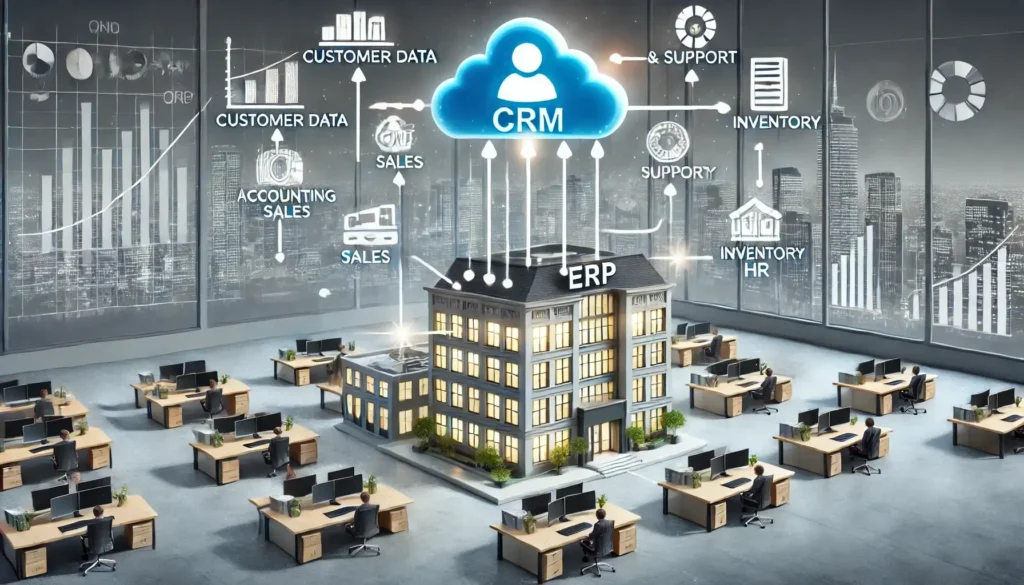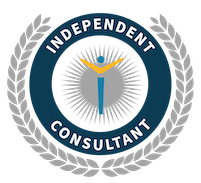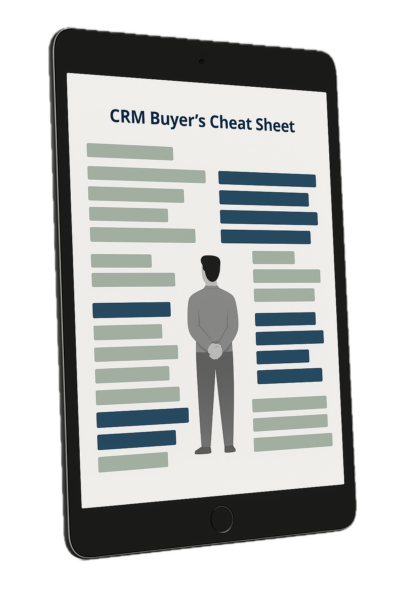Often, people involved in the CRM buying process for their organization express an interest in integrating a new CRM system with their legacy ERP or accounting system.
Many ERP and accounting systems are on the market, ranging from QuickBooks to Epicor to SAP.

“CRM ERP integration” can mean a lot of different things to a lot of different people. Since this is such a broad characterization of the interoperability of disparate systems, it is helpful to break the topic of CRM to ERP integration into its different components or touchpoints to define better what ERP integration means for a specific organization.
The default functionality can handle some ERP-to-CRM integration touchpoints within an off-the-shelf CRM-to-ERP integration package.
While these types of packages can significantly simplify certain integration components, some level of configuration is always required. Also, the “one size fits all” solution may not always be exactly that—modifications to core integration functionality may need to be made.
Other integration touchpoints may require custom functionality to be built out because a particular integration requirement is not common enough for an integration package vendor to have pre-baked it into their solution.
It’s important to identify each potential integration touchpoint and then determine whether it applies to your business. If it does, the next step is determining whether the benefit to that connection outweighs the cost of implementing or developing it. Let’s look at some common CRM ERP integration touchpoints.
Creation of an ERP Customer Master Record From a CRM Account Record
If your company is in a high sales transaction business and your sales team is signing up many new customers daily, there are identifiable benefits to automating the process of turning a CRM account into an ERP customer. This integration could save a lot of time compared to the current process of, for example, the sales department emailing new customer information to the accounting department and then someone in accounting manually entering each new customer into the ERP system.
However, if your company sells a high-ticket item and you only acquire one or two new customers per week, you might want to consider whether it makes financial sense to automate this process.
View Customer Financial Summary Information in CRM
This is one of the most common integration touchpoints between ERP and CRM. It is also standard in most pre-packaged integrations as it’s one of the easier integration touchpoints to achieve technically. As long as a CRM account record has an ERP customer ID, fields such as YTD Sales, MTD Sales, A/R aging, and a Credit Hold flag can be mapped across into a CRM Account record.

View Invoice History and Sales Order History in CRM
As with Financial Summary information, invoice and sales order history is a common and relatively easy to achieve integration touchpoint. This involves more structure in the CRM database as these transactions represent many-to-one information. A given account can have only a few or it can have a lot of related transactions.
CRM Quote to ERP Order
Before deciding whether this integration touchpoint makes sense, it should first be evaluated whether the CRM system that you are planning to implement:
a) can handle your existing quotation process with out of the box functionality
b) requires a third-party CRM add-on to support the complexities of your quoting process
or
c) your sales quoting is such an ad hoc process, that you should continue to use applications such as Word or Excel for your sales quotes
The other area to evaluate is whether your ERP inventory and non-inventory items would even be manageable within a CRM sales quoting system. For example, if you have fewer than a couple of dozen inventory items in ERP that are relevant to sales quotes, it’s likely that those items could be easily managed within a CRM sales quoting system.
But what if you have hundreds or even thousands of inventory items in ERP, any ones of which could be quoted to a prospect or customer? This quantity of items could render sales quoting within CRM — and therefore the whole idea of CRM quote to ERP order — impractical. Your existing sales quoting system may continue to be the best option, even with a new CRM system in place.
Field Service Integration With CRM
Because most CRM systems have Case management functionality, it often makes sense for field service representatives (FSRs) to be CRM users.
If a company sells the type of product that means resolving a customer Case may require dispatching an FSR to the customer site, certain support Cases can be reassigned to FSRs. If an FSR needs to replace parts on customer-owned equipment, the FSR may need to provide a quote to the customer for repair, which may include ERP inventory line items.
Repair quotes are not normally a standard part of CRM functionality, so this process will likely not be included in pre-developed CRM to ERP integration packages and would have to be custom developed.
Integrated RMA Management
An RMA request is often originated from a CRM support case. If a customer support representative cannot solve a customer issue via phone or via remote diagnostics, a new part or a new unit may need to be shipped to the customer. Alternatively, the defective part may need to be shipped back for repair and then returned to the customer.
The way RMA processing is handled can vary considerably from company to company, so this is often a CRM to ERP process that needs to be customized — and this can be one of the more involved (i.e. more expensive) customizations.
Depending upon the volume of RMA requests, this may or may not make financial sense to develop as an integration touchpoint.
Professional Services and Other Time Billing
While (PSA) Professional Services Automation functionality within a CRM system is often accomplished with a third party add-on, if this type of functionality is added to a CRM system, another integration touchpoint might be the integration of logged, hourly or daily professional services into ERP for customer billing.
This integration touchpoint is one that would likely require custom development.
Other CRM ERP Integration Touchpoints
There may be additional touchpoints that you have envisioned for your organization that are not included in the above sections.
As you go through the CRM buying and requirements process, it’s important to break “ERP integration” into its various components. By doing this, you will be able to more precisely communicate your requirements to a CRM services company representative, who can then communicate pros and cons as well as estimated overall costs.




